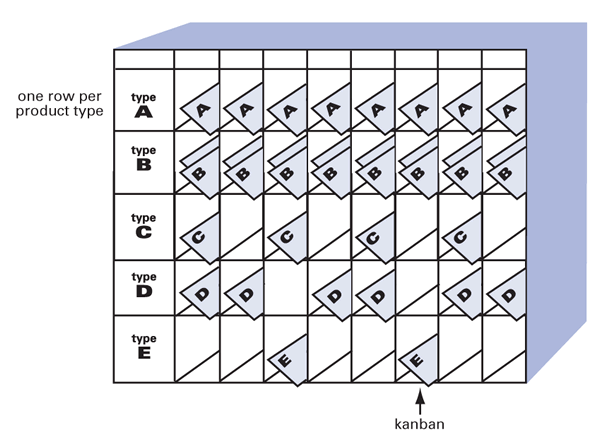Heijunka
Heijunka is leveling the type and quantity of production over a fixed period of time. This enables production to efficiently meet customer demands while avoiding batching and results in minimum inventories, capital costs, manpower, and production lead time through the whole value stream. In Japanese, the word heijunka means, roughly, “levelization.”
With regard to leveling production by quantity of items, suppose that a producer routinely received orders for 500 items per week, but with significant variation by day: 200 arrive on Monday, 100 on Tuesday, 50 on Wednesday, 100 on Thursday, and 50 on Friday. To level production, the producer might place a small buffer of finished goods near shipping, to respond to Monday’s high level of demand, and level production at 100 units per day through the week. By keeping a small stock of finished goods at the very end of the value stream, this producer can level demand to its plant and to its suppliers, making for more efficient utilization of assets along the entire value stream while meeting customer requirements.
With regard to leveling production by type of item, suppose that a shirt company offers Models A, B, C, and D to the public and that weekly demand for shirts is five of Model A, three of Model B, and two each of Models C and D. A mass producer, seeking economies of scale and wishing to minimize changeovers between products, would probably build these products in the weekly sequence A A A A A B B B C C D D.
A lean producer, mindful—in addition to the benefits outlined above—of the effect of sending large, infrequent batches of orders upstream to suppliers, would strive to build in the repeating sequence A A B C D A A B C D A B, making appropriate production system improvements, such as reducing changeover times. This sequence would be adjusted periodically according to changing customer orders.

Heijunka versus Batch and Queue

Many assembly departments think it is easier to schedule long runs of one product type and avoid changeovers. However, they pay heavily in the end across multiple dimensions:
- Lead time — Batch production expands lead times. So it becomes difficult to serve customers who want something different than the batch we are making now. Therefore, we have to invest money in finished goods, hoping that we will have on-hand what the customer wants.
- Materials and parts — Batch production also means that we consume raw materials and parts in batches, which swells WIP inventories and places the burden of mura (unevenness) on suppliers.
- Quality — Batch production hides defects. Quality suffers because a single defect becomes replicated throughout the batch.
- Impact on workers — Workers experience unevenness—that is, some lines are very busy, others idle—which also degrades efficiency. The unevenness in the work creates strain, which corrodes safety and morale.
How to Decide Your Production Scheduling Method: ABC Production Analysis
To transform your system from batch-and- queue to heijunka, you have to decide the scheduling method you will use to produce finished goods for your customer. First, perform an ABC Production Analysis as shown below.

How to Calculate Finished Goods Inventory for Each Product

Additional Resources on Heijunka

Book
Creating Level Pull

Book
Kaizen Express



